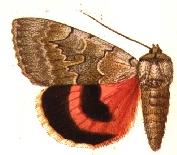Catocala Concumbens on:
[Wikipedia]
[Google]
[Amazon]
''Catocala concumbens'', the sleepy underwing or pink underwing, is a  The
The
"''Catocala concumbens'' Walker 1858"
''Moths of North Dakota''. Retrieved November 13, 2020. concumbens Moths of North America Moths described in 1858 {{Catocalini-stub
moth
Moths are a paraphyletic group of insects that includes all members of the order Lepidoptera that are not butterflies, with moths making up the vast majority of the order. There are thought to be approximately 160,000 species of moth, many of ...
of the family Erebidae. The species was first described by Francis Walker in 1858. It is found in eastern North America, west across the southern half of the Prairie Provinces to eastern Alberta
Alberta ( ) is one of the thirteen provinces and territories of Canada. It is part of Western Canada and is one of the three prairie provinces. Alberta is bordered by British Columbia to the west, Saskatchewan to the east, the Northwest Ter ...
.
wingspan
The wingspan (or just span) of a bird or an airplane is the distance from one wingtip to the other wingtip. For example, the Boeing 777–200 has a wingspan of , and a wandering albatross (''Diomedea exulans'') caught in 1965 had a wingspan ...
is 60–75 mm. Adults are on wing in August in one generation depending on the location.
The larvae feed on ''Populus
''Populus'' is a genus of 25–30 species of deciduous flowering plants in the family Salicaceae, native to most of the Northern Hemisphere. English names variously applied to different species include poplar (), aspen, and cottonwood.
The we ...
'' and ''Salix
Willows, also called sallows and osiers, from the genus ''Salix'', comprise around 400 speciesMabberley, D.J. 1997. The Plant Book, Cambridge University Press #2: Cambridge. of typically deciduous trees and shrubs, found primarily on moist s ...
'' species.
References
External links
*"''Catocala concumbens'' Walker 1858"
''Moths of North Dakota''. Retrieved November 13, 2020. concumbens Moths of North America Moths described in 1858 {{Catocalini-stub